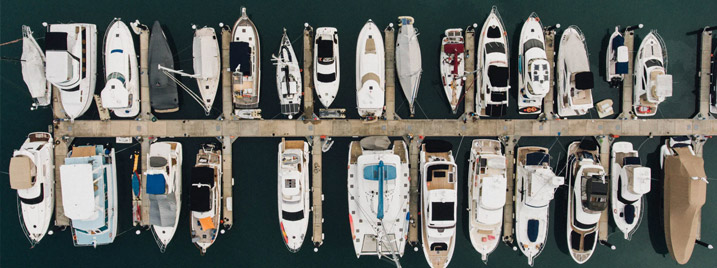
Boats are generally pretty expensive and it is therefore worth protecting the investment by mooring up with good quality fenders and mooring lines. However, all too often, boats costing hundreds of thousands of pounds can be seen secured with poor quality or worn lines or fenders. Even worse, incorrect attachment of mooring lines could leave your boat being battered against the dock even in moderate weather conditions.
Nylon lines are good as they tend to last a long time, wear well and have some elasticity which reduces the effect of shocks on your boat caused by movement.
If your boat is to be left moored up for a long time, especially over winter, it’s a good idea to double up on the mooring lines. This spreads the load, extending the life of your lines and provides a backup should one fail. The addition of chafing gear to parts of the lines that will be subject to wear - for example where they run through fairleads - is also a good idea. Chafing gear can be a leather wrapping, an additional layer of braiding or a used fire hose or similar.
Marinas are often busy and sometimes it’ll be difficult to find a mooring especially in peak season. If you expect your marina to be crowded, aim to get there early before the crowds. It is also a good idea to radio ahead to the marina letting them know your vessel size. They will often point you in the right direction to an empty berth – saving you the effort of searching.
If you are not familiar with the particular marina, it is worthwhile going past your mooring first to take a look at the mooring cleats or bollards. Check where the wind and tide is coming from and brief the crew accordingly.
Before making your approach to the pontoon or dockside, make sure that you have enough fenders out on the side that’ll be against the dock. They should be at the correct height and should be spread out along the length of the boat. The rearmost fender should be about level with the rear stanchion and the foremost between the first guardrail and pulpit.
Mooring ropes should be attached to the bow and stern cleats of the boat and should be passed through the fairleads and underneath the guardrails so that the guardrails are not snagged when the lines are secured to the dock. Usually, the crew members will hold these lines with three or four coils and stand at the widest point of the boat ready to jump onto the dock when it’s close enough.
Ideally, the boat should approach the pontoon heading into the wind or tide at an angle of about 30-40°. As the boat gets close to the dock it should be turned away to allow the stern to swing in, and then the engines should be reversed to stop the boat.
The two crew members holding the bow and stern lines now step onto the dock and secure the lines to the dock cleats.
If the boat is only to be moored up for a very short time (for example when re-fuelling) and the weather conditions are calm, the bow and stern lines may be enough. However, boats moored only on bow and stern lines will move back and forth along the dock.
Adding spring lines will prevent this movement and should be employed whenever mooring up for any length of time. The stern spring should run from the stern of the boat to a position on the dock close to the bow of the boat. Likewise, the bow spring should attach the bow of the boat to a point on the dock further aft. Commonly the stern spring is attached to the same cleat on the dock as the bow line, and the bow spring is tied off to the stern line dock cleat.
Mooring Alongside Another Boat
Ideally you’ll want to moor directly against the pontoon or dock. However, in peak season, there may not be enough space in the marina to do so. In this case you’ll have to moor alongside another vessel.
It is best to moor against a boat of a similar size or larger than your own. Sailing and power boats don’t moor alongside well because of their different shapes. Where possible, you should ask permission before mooring against another boat. Preferably choose a boat that intends to leave the marina at the same time or later than you.
Breast ropes should be used between the bows and sterns of each boat and spring lines should be secured from the bow of each to stern of the other. It is also a good idea to attach lines from the bow and stern of the outer boat directly to the dock. This ensures that the force of the wind or tide is shared between the boats.
Make sure that the masts of the two boats are offset. If they are in line, then waves may roll the boats making the masts collide with each other.
Leaving From An Inside Berth When Another Boat Is Rafted Alongside
The easiest way for rafted boats to depart the marina is for the outside boat to leave first. However, this is not always possible.
In the event that the inner boat needs to leave first, ideally, it should leave the dock travelling down-wind or down-tide.
Both boats should start their engines and have all ropes removed except direct bow and stern shore lines.
The boat immediately outside of the one that is leaving should have a line running from its stern around the front of the leaving boat and back to the dock. As the inner boat reverses out, the outer boat moves forwards and takes up the slack on the bow line and new stern line.